Incompatibility and Male Sterility and their Utilization in Crop Improvement - 2 | Agriculture Optional for UPSC PDF Download
Male Sterility
Male sterility is a condition where pollen grains do not function properly, but female gametes operate normally. This condition is sporadically observed in nature.
Morphological features of male sterility
Male sterility in plants can result from various factors such as mutations, chromosomal abnormalities, cytoplasmic elements, or a combination of cytoplasmic and genetic factors.
These factors can lead to several morphological changes in male sterile plants, including:
- Lack of viable pollen grain formation. The sterile pollen grains are typically transparent and may only faintly take up stains.
- Anther non-dehiscence, meaning that the anthers do not open up to release pollen grains, even if viable pollen is present inside. This could be due to a rigid outer layer that restricts the release of pollen.
- Abortion of the androecium (the male reproductive part of the flower) before pollen grains are formed.
- Malformation of the androecium, making it impossible for pollen grains to develop.
Kinds of male sterility, maintenance and uses
Male sterility in plants can result from a combination of cytoplasmic, genetic, and environmental factors.
Depending on these factors, male sterility can be classified into several categories:
- Cytoplasmic Male Sterility (CMS)
- Cytoplasmic-Genetic Male Sterility (CGMS)
- Genetic Male Sterility (GMS)
Under Genetic Male Sterility (GMS), there are two categories:
- Environment-Insensitive Genic Male Sterility, often simply called Genetic Male Sterility.
- Environment-Sensitive Genic Male Sterility or Environmental-Induced Sterility, which can be further subdivided into:
- Thermosensitive Genic Male Sterility (TGMS)
- Photosensitive Genic Male Sterility (PGMS)
- Photo-Thermosensitive Genic Male Sterility.
These categories reflect the different factors and conditions that can lead to male sterility in plants.
Cytoplasmic Male Sterility (CMS)
Cytoplasmic male sterility (CMS) is primarily caused by mutations in the mitochondria or other cytoplasmic factors located outside the cell nucleus. This type of sterility does not involve nuclear genes. In some cases, evidence suggests that specific genes within the cytoplasm may be responsible for conditioning cytoplasmic male sterility. For instance, in maize, it has been observed that DNA can be found in mitochondria and may be situated within a plasmid-like element.

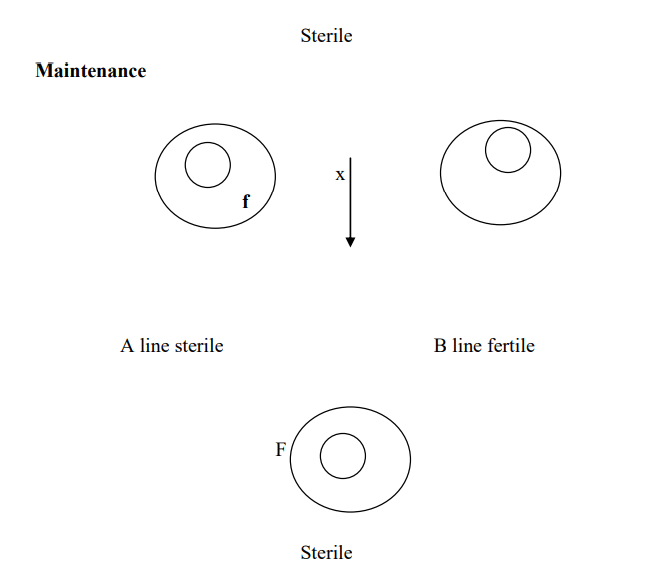
Since mother contributes the cytoplasm to the offspring, the sterility is transferred to the F1.
Uses:
Cytoplasmic male sterility (CMS) is valuable in crops where seed production is not the primary goal, particularly when there are no available R lines (restorer lines). For example, in crops like onions and various ornamental plants, the resulting hybrids demonstrate significant hybrid vigor, leading to longer vegetative phases, larger flower and bulb sizes. In maize, cytoplasmic male sterility has been effectively utilized to produce double cross hybrids.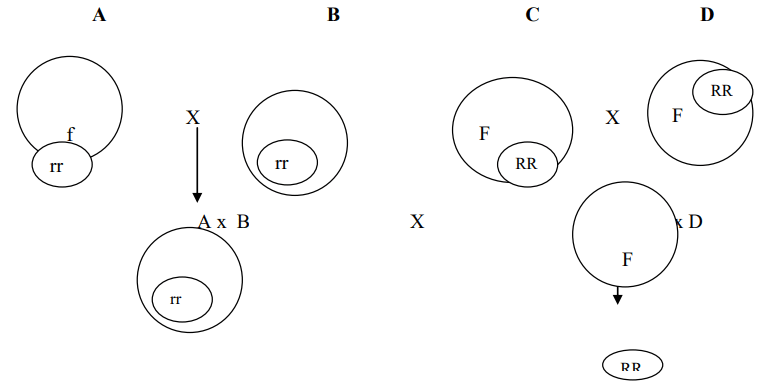
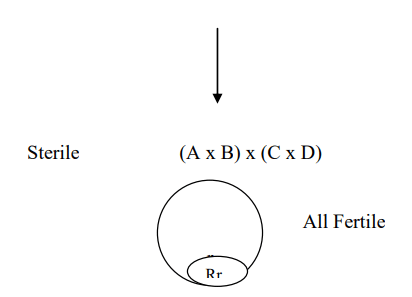
Genetic Male Sterility (Gms)
Typically, genetic male sterility is determined by nuclear recessive genes, represented as ms ms. However, there is an exception in safflower, where male sterility is controlled by a dominant gene, Ms Ms. This form of male sterility is employed in the production of hybrids in crops like redgram and castor.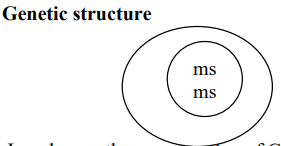
In red gram there are number of GMS lines are available. E.g. Ms Co 5, Ms T21
Maintenance
In genetic male sterility, the sterile line will be maintained from heterozygous condition. The genetic structure of heterozygous line will be.
When this heterozygous line is grown in the field it will segregate in the ratio of 1 Fertile : 1 sterile.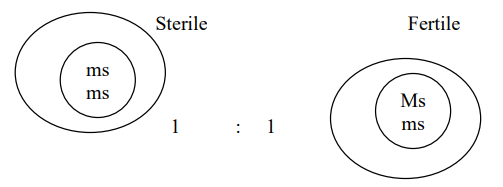
In the hybrid seed production process, pollen from the fertile line is used to pollinate the sterile line, resulting in seed production in the sterile line. These seeds are then harvested for hybrid seed production. To grow hybrid seeds, the collected seeds from the sterile plants are sown at double the normal seed rate because they will segregate in a 1 : 1 ratio of fertile to sterile lines. When the plants flower, the fertile line can be identified by its yellow, plump anthers and should be removed from the field. This leaves only the sterile line in the field, which will be pollinated by the R line. The offspring obtained, known as R1, will be hybrid redgram seeds.
Utilisation: Hybrid development. Eg: Redgram
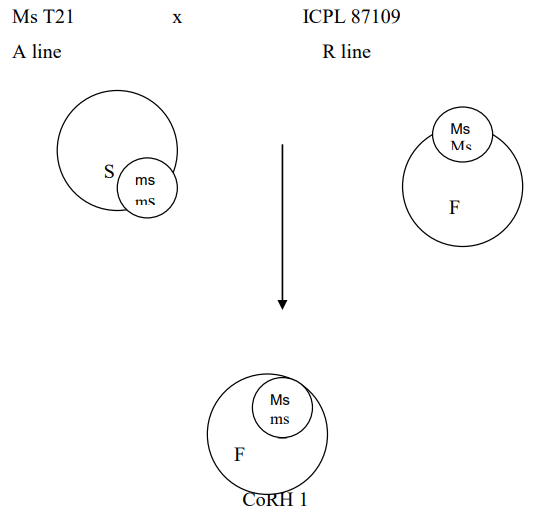
Difficulties in use of Gms:
- GMS maintenance demands skilled labor for the identification and labeling of fertile and sterile lines, which is both time-consuming and expensive.
- In hybrid seed production fields, recognizing the fertile line and eliminating them can be a costly process.
- The utilization of double the seed rate for GMS lines can also lead to increased expenses.
- In certain crops like castor, elevated temperatures can result in the loss of male sterility, further complicating GMS utilization.
Transgenic Genetic Male Sterility
- A gene that is introduced into an organism's genome using recombinant DNA technology or genetic engineering is referred to as a transgene. Many transgenes have been identified to induce genetic male sterility, which is dominant over fertility. Consequently, it's crucial to establish an effective system for restoring fertility when using these transgenes for hybrid seed production. An effective restoration system is found in at least one case, known as the Barnase or Barstar system.
- The Barnase gene from Bacillus amyloliquefaciens encodes an RNA that, when driven by the TA 29 promoter, is only expressed in tapetum cells, leading to their degeneration. Transgenic tobacco and Brassica napus plants expressing Barnase become entirely male sterile. Another gene, Barstar, from the same bacterium, encodes a highly specific inhibitor of Barnase RNase. Therefore, transgenic plants expressing both Barstar and Barnase are fully male fertile.
- The Barnase gene has been linked to the bar gene, which provides resistance to the herbicide phosphinothricin. This male sterile line is maintained by crossing it with a male fertile line. The resulting progeny consist of a 1 : 1 ratio of male sterile to male fertile plants; the latter can be easily eliminated at the seedling stage using a phosphinothricin spray. The male sterile plants are then crossed with the Barstar line to obtain male fertile hybrid offspring. However, this system of male sterility has not yet been put to commercial use.
- The use of Thermosensitive Genetic Male Sterility (TGMS) or Photosensitive Genetic Male Sterility (PGMS) addresses this issue. These male sterile lines are maintained by growing them in regions where the temperatures and photoperiods during the critical developmental stages result in complete male fertility (in terms of appearance). Selfed seeds from these lines are then cultivated for hybrid seed production in areas where their ms genes render them completely male sterile due to the prevailing temperature and photoperiod conditions. In this way, all plants in the male sterile line will be sterile, and no rogue plants will need to be removed. TGMS and PGMS are currently employed in the development of hybrid rice in China.
Cytoplasmic Geneic Male Sterility
In this scenario, we have cytoplasmic male sterility where fertility is restored by dominant nuclear genes. This system is applied for generating hybrids in crops like pearl millet, sorghum, maize, rice, wheat, and various other crops.

- A line or ms line: This term refers to a male sterile line within any of the categories mentioned above. The A line consistently serves as the female parent in the production of hybrid seeds.
- B line or maintainer line: This line is employed to preserve the sterility of the A line. The B line is an isogenic line, meaning it is genetically identical to the A line in all traits except for its fertility status.
- R line and restoration of fertility: Also known as the Restorer line, it is responsible for reinstating fertility in the A line. When the A line is crossbred with the R line, it produces F1 fertile hybrid seeds, which have commercial significance.
Maintenance
The A line which is male sterile is maintained by crossing it with isogenic B line which is also known as maintainer line. The B line is similar to that of A line in all characters (isogenic) except fertile cytoplasm.
Utilisation
The male sterile. A line is crossed with R line (Restorer) which restorers fertility in F1.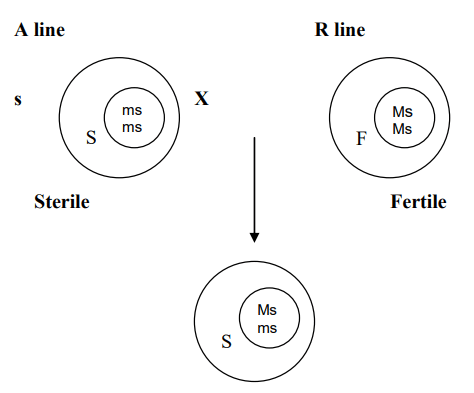
Hybrid Fertile
Limitations of CGMS lines
- Restoring fertility poses a challenge, as seen in the case of rice.
- Crops like rice may have low seed set, necessitating the use of special techniques to increase it.
- Male sterility may break down at higher temperatures.
- Developing an effective R line is challenging in crops like wheat, which have a polyploidy series.
- Undesirable effects of cytoplasm can occur, such as the susceptibility of Texas cytoplasm in maize to Helminthosporium or Tift 23 A cytoplasm in bajra becoming susceptible to downy mildew.
- The effectiveness of cytoplasmic male sterility may be reduced by modifier genes.
|
52 videos|224 docs
|
















